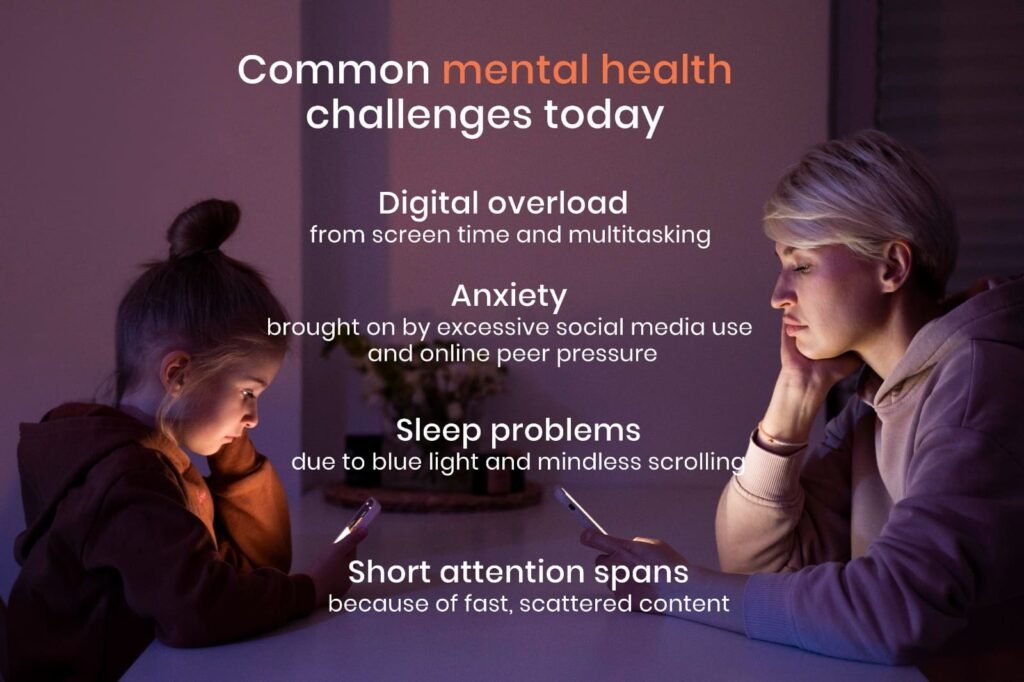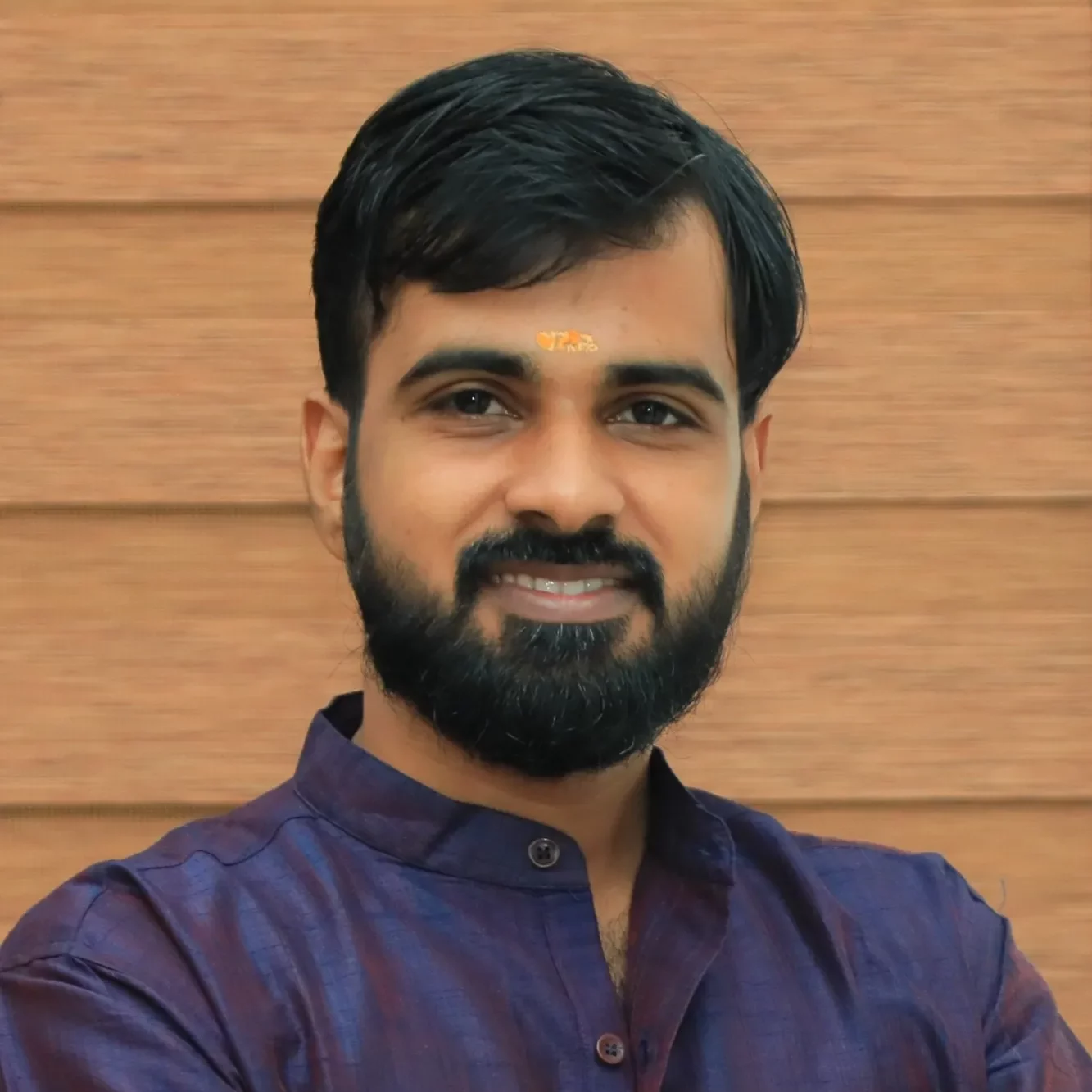Table of Contents
ToggleThe days covered now are moving so quickly; the ability to find mental balance or patience is becoming very difficult to achieve. Life today is initially consumed by screens, messages, and social media. Notifications are constant and demanding, work stress is inevitable, and social media is becoming a routine. These realities are daily masking your emotional well-being. Enter yoga for mental balance. Yoga is a science that establishes clarity, calmness, and mind control when everything around us moves at hyper-speed.
Mental Health in the Digital Age
The digital age has many advantages. But it also brings overstimulation. We are constantly switching between apps as we are inundated with information. This creates stress, distraction, and poor sleep.
Common mental health challenges today include:

● Digital overload from screen time and multitasking
● Anxiety brought on by excessive social media use and online peer pressure
● Sleep problems due to blue light and mindless scrolling
● Short attention spans because of fast, scattered content
Yoga’s Advantages for Mental Health Balance
Yoga offers straightforward, yet effective tools for enhancing mental health and wellness. It uses postures (asanas), breathing techniques (pranayama), and meditation to support restoring emotional balance.
Here’s how each component helps:
● Breathing Exercises for Anxiety (Pranayama)
Calm breathing appraises the nervous system of a mammal, compensating for shallowness of breath during stress. The postural practice of Pranayama, like Nadi Shodhana (alternate nostril breathing) or Bhramari (humming breath), aids in achieving a relatively quick mental calmness. Dry breath aggravates mental tension and inhibits mental clarity.
● Meditation for Mental Calmness (Asanas)
Some poses do relax the body as well as the mind. These include or provide some of the same effects as Balasana (Child’s Pose), Viparita Karani (Legs-Up-the-Wall), and Paschimottanasana (Seated Forward Bend); they either release built-up tension in the body or mental fatigue.
Doing these poses every day instills calm into your life.
● Yoga and Mindfulness (Meditation)
Meditation is all about being aware of your thoughts without reaction. A few minutes a day, five to ten, of this mindful meditation will lower stress, and enhance focus, emotional regulation, and adaptability to pressure.
In effect, this provides a firm basis from which to build mental health in the digital world.
Scientific Proof: Yoga and Brain Health
Yoga is not just a traditional practice—it’s supported by modern science.
Studies show:
● It reduces the cortisol, the primary stress hormone. If you are practicing Yoga regularly.
● It increases GABA, a neurotransmitter related to focus and calmness.
● Brain scans show that grey matter density in the brain- which is related to memory and emotion regulation- has increased.
● It increases serotonin, and dopamine are neurotransmitters that improve mood and help with depression.
Yoga and brain health are actually related, quantifiable, and supported by neuroscience.
Digital Detox Yoga: A Practical Approach
You don’t need to quit digital life—you need to manage it better. Digital detox yoga is a way to reset your nervous system and bring back balance.
Here’s something to try:
● Morning: Before checking your phone in the morning, spend ten minutes stretching and taking deep breaths.
● Mid-day: Take a short breathing exercise for anxiety—just 3–5 minutes, breathe in, breathe out, a session to calm the mind between tasks.
● Evening: Understand and do with gentle yoga poses for mental calmness to release physical tension after screen time.
● Weekend: Follow a digital detox day once a week or month. Avoid all screens and focus on movement, rest, and connection with nature.
Yoga as a Way of Life Change
Practice yoga changes energy, mood, and quality of sleep, and has improved over time. This personal change is regarded as a yoga lifestyle change—a slow and logical progression in how you handle stress and develop your emotional intelligence.
Positive results include:
● Better sleep without depending on screens at night
● Fewer emotional reactions to stressful situations
● Increased self-awareness and reduced digital dependency
● More energy throughout the day
● Improved relationships and focus at work
Yoga doesn’t just reduce stress; it teaches you how to respond better to life itself.
Beginner Yoga for Mental Clarity
If you are new to yoga, simply try it. Yoga for mental clarity for beginners does not require any specialized equipment or previous knowledge.
Simple steps:
● Spend almost 15 minutes each day practicing.
● Use free apps, yoga for beginners or down dog, to assist you in your sessions.
● Focus on basic poses that stretch the hips and spine.
● Avoid distractions. Turn off notifications on your phone.
● You will definitely see a difference if you compare your mood before and after each session.
Yoga for Inner Balance in a Digital World
The ability to achieve stillness is by far yoga’s greatest advantage. You can learn to pause, breathe, and react mindfully in a world that demands your full attention by practicing yoga for inner balance.
This balance is not external. It comes from inside:
● Learning to pause before reacting
● Building awareness of emotions and thoughts
● Returning to breath when overwhelmed
● Feeling grounded, even during chaos
You begin to live life with more clarity, confidence, and calm.
Final Thoughts: The Future requires Inner Strength
While the digital world continues to give you “things to do,” it is also compelling you to forge more of the inner strength needed to keep balance in that endeavor. And yoga provides the infrastructure of that strength. Whether you are a student, a working professional or a parent, it is critical that you have the clarity of mind we need on a daily basis. You now have the opportunity to create that clarity and inner peace through yoga.
Hidden mantra Blogs provides guided yoga programs that are simple, effective, and attainable in our busy, tech-driven lives. If you’re looking for more than a brief reprieve from your hectic existence and want a meaningful place to start, Hidden mantra Blogs is the place to start. Discover the vast collection of articles on everything from mindfulness and Buddhism to yoga and Indian culture.
Check out Hidden mantra Blogs today and start your journey toward calm, focus, and self-awareness.
Namaste.
Also Read: The Power of Yoga For Mental Health









